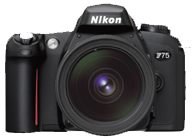 Sunset
over the Pacific,
Rarotonga, The Cook Islands, February 2004
|
|
The
Equipment Fuji
4700 MX
digital camera, 2001-2004 Fuji
4700 MX
digital camera, 2001-2004Most of the photos on this site were taken with a Fuji 4700 bought in 2001. I took the photos at a medium size resolution of 1280 x 960 (about 1.2mp) and at medium JPEG quality. I've printed many of these photos at 81/2" x 11" and they've come out great. This camera was my first digital. It was great to travel with because of its size, relatively fast operation, and use of standard AA batteries. The camera also used Fuji's first generation SuperCCD which I think produces great colour & contrast. My mom is now enjoying snapping photos of my cat and her friends with it!  Nikon
F75 35mm
Film SLR, 2003- Nikon
F75 35mm
Film SLR, 2003-In the summer of 2003, I purchased a Nikon F75 SLR for a winter backpacking trip to Asia, New Zealand, and the Pacific. This is a beginners to intermediate level SLR which is excellent for learning more about the technical aspects of photography; specifically shutter speeds, aperture, and film ISO speeds. It's a very light, small camera, that is easily packable. I equipped it with a 24-85mm wide-angle lense, and took hundreds of 35mm photos with it. Using it was very enjoyable, and made it easier when composing photos. Over the next few months of 2005, I will be scanning the negatives and publishing them online.  Canon
S410
digital camera, 2004 - Canon
S410
digital camera, 2004 -In 2004, I replaced my Fuji camera with a compact Canon S410 (also known as the S430), a 4mp camera. I chose this camera after months of frustrating shopping to find a compact camera that takes great photos. I haven't taken many photos with this camera yet, and I must admit that I am still somewhat biased to pictures taken by the Fuji! Still, I expect it will take thousands of photos in 2005. |
Suggestions for Cameras and taking Photos There is a saying that goes the best camera, is the camera you can carry with you. It's not much good if it's so big that you never have it with you! There are generally two types of cameras; the compact Point & Shoot types, and the SLR/serious amateur type cameras. The former being cameras you just turn on, point and shoot. This leads alot of people to believe that Point & Shoot cameras can't take good pictures, but that's not really true in the digital age. Most of my photos have been taken with Point & Shoot cameras; you can do quite a bit with them -- if you try. Having a camera is only a small bit of the story to taking a good picture though. You need to also consider composition, location, and lighting at a minimum. It's like playing tennis. Someone with an expensive $300 racket won't play better if they don't improve their skill as well. Remember the camera is only part of taking a good photo, with choosing a camera. Buying something beyond your needs will not likely improve your photos. Digital cameras have reached a point where you can get a good point & shoot for $250 US, and they usually have enough features for most people. A 4mp camera is more than sufficient to produce quality 81/2" x 11" photos as printouts. In my opinion, there is little benefit in getting cameras higher than 6mp for anyone who isn't very serious about their photography. After the Click So you've got 390 photos from your trip to the volcanoes of Hawaii - now what? Well, you need to load them on your computer; throw half of them away; clean up several; and put the best on the internet to share with your friends. Sounds pretty simple doesn't it? Unfortunately, until recently this was alot of work -- so much in fact, that I wasn't able to do it easily until 2004. It may seem like an obvious statement, but good software that integrates well can make or break a project like getting your photos up on the internet. For this site, I used Apple's iPhoto (free with every Mac) to store all my photos (approximately 4900 in Jan 2005). I then created albums of the best photos. Next, I used a free application called Galerie that integrates with iPhoto to create contact sheets and the web pages for each album. Finally, to create the home page, I used NVU (another free application) to produce the layout. |